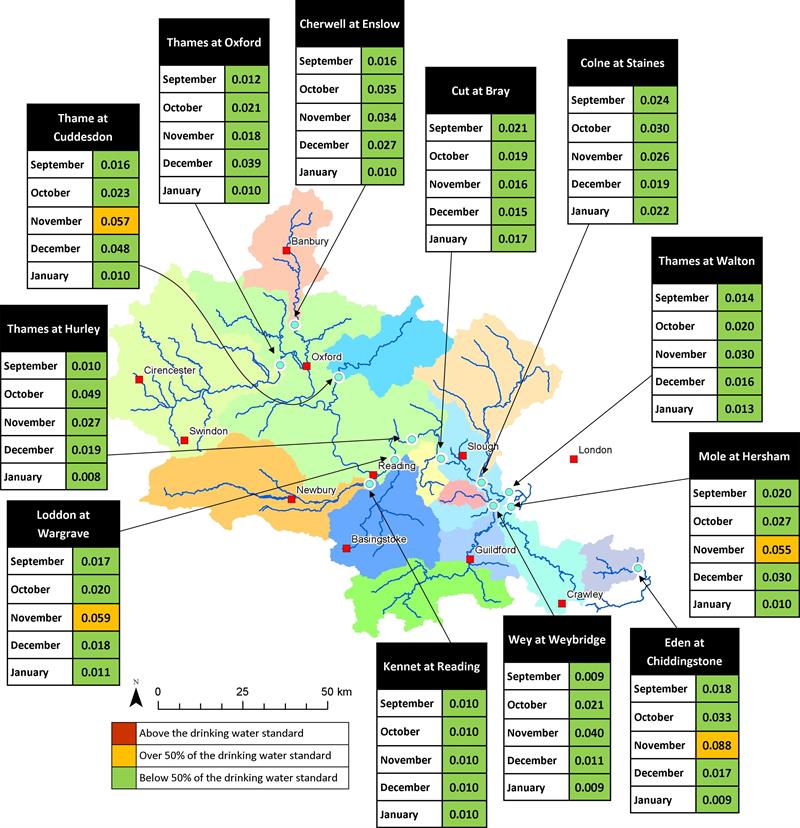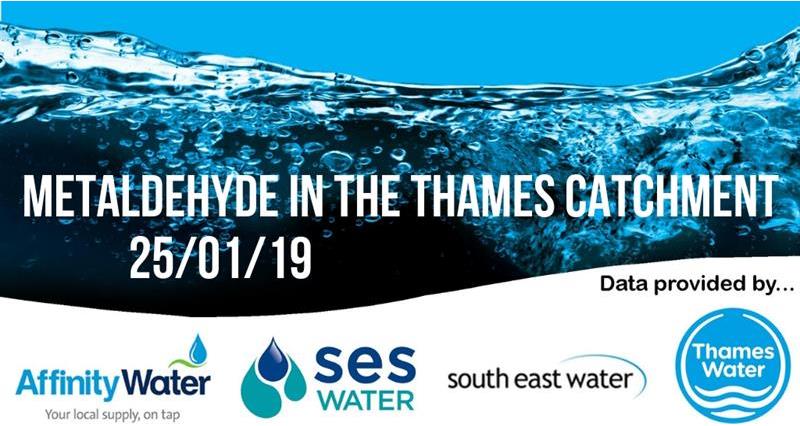Metaldehyde in the catchment
In preparation for the phasing out of metaldehyde, you may wish to consider reducing your reliance on chemical control measures more generally, by adopting a wider range of options in your Integrated Pest Management (IPM) programme to control slug numbers. If you need to use chemical control, use ferric phosphate based pellets instead of metaldehyde. However, if you do choose to use metaldehyde based pellets before the ban is imposed, it is more important than ever to follow stewardship and best practice guidelines and to consider implications to water before making any applications.
In some areas there are water company funded initiatives available to support you until the ban comes into force, so contact your local water company to find out more. Note that contact details can be found at the bottom of this update.
Season summary
The infographic below shows the maximum recorded concentrations per month at each of the 12 monitoring locations across the Thames catchment. All results are concentrations of metaldehyde in river water in micrograms per litre (µg/l).
Although high concentrations were detected in some small tributaries across the catchment, no results were recorded above the drinking water standard at any of the 12 river monitoring sites we have been sharing results from this autumn.
Heading into the start of the autumn slug pressure was minimal. This was a direct result of the heatwave experienced over the summer, which meant conditions were generally unfavourable for slug activity. There was however a particular concern that the baked, and in some cases cracked, soil conditions following the long, hot summer would provide a direct pathway for metaldehyde to reach watercourses if heavy rain did suddenly arrive and applications had been made. Fortunately, this did not happen.
September and October were characterised by occasional rainfall events, which were separated by lots of dry days. This combined with higher than average temperatures for the time of year meant that soil moisture remained low, prolonging the unfavourable slug conditions. If pellets were applied during this period, it is highly likely that some of them would have been consumed before they could be washed off into watercourses.
November was a wetter month and temperatures cooled. This resulted in soils steadily wetting up throughout the month, increasing the likelihood of slug activity. Heavy rainfall recorded on the 10th-11th November (up to 30mm in some areas of the catchment) resulted in the first real ‘flush’ of metaldehyde into watercourses this season. This was observed at four of the 12 sampling locations with concentrations rising above half the drinking water standard in the days following the rainfall, peaking at 0.088µg/l in the Eden at Chiddingstone on 12th November.
Metaldehyde concentrations throughout December remained well below the drinking water standard across all 12 sampling locations. Although rainfall became more frequent and soils continued to wet up as the month progressed, weather conditions earlier in the autumn meant that slug populations were low so fewer slug pellet applications were needed than in previous years. The warm start to the season also allowed for crops to grow away from slug pressure earlier in the season, reducing the likelihood of applications later in the season when significant rainfall did finally arrive.

As crops are now established the need for slug pellets has significantly reduced. Although water companies will continue to monitor for metaldehyde in rivers, the risk of concentrations exceeding the 0.1µg/l standard at abstraction points for drinking water treatment is now low and therefore this will be the last update of the season.
Thank you for engaging with the metaldehyde updates from your local water companies this season.
To find out more please contact:
Affinity Water: Q2F0Y2htZW50TWFuYWdlbWVudEBhZmZpbml0eXdhdGVyLmNvLnVr, SES Water: Y2F0Y2htZW50QHNlc3dhdGVyLmNvLnVr, South East Water: Y2F0Y2htZW50QHNvdXRoZWFzdHdhdGVyLmNvLnVr or Thames Water: Y2F0Y2htZW50Lm1hbmFnZW1lbnRAdGhhbWVzd2F0ZXIuY28udWs=
